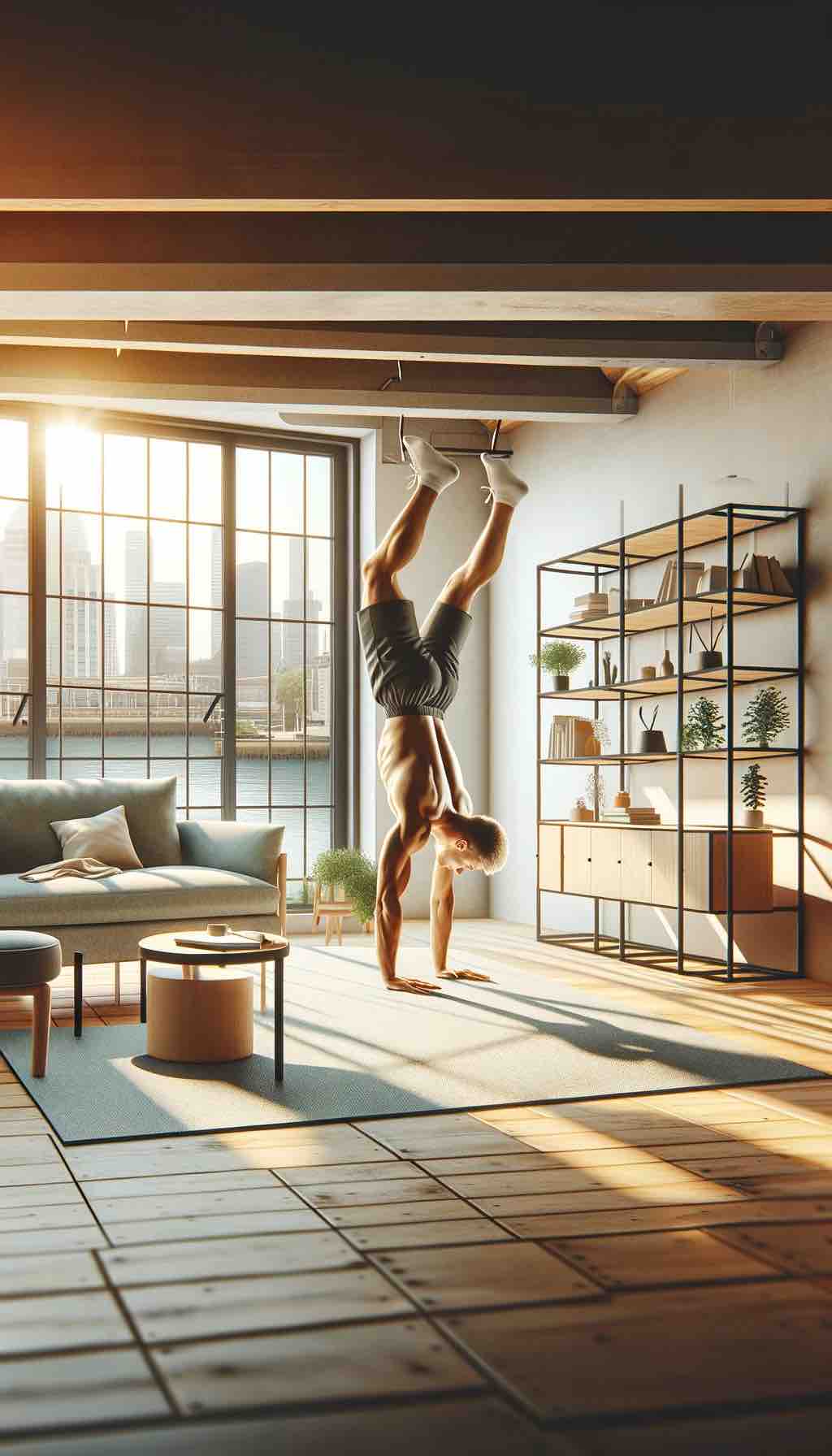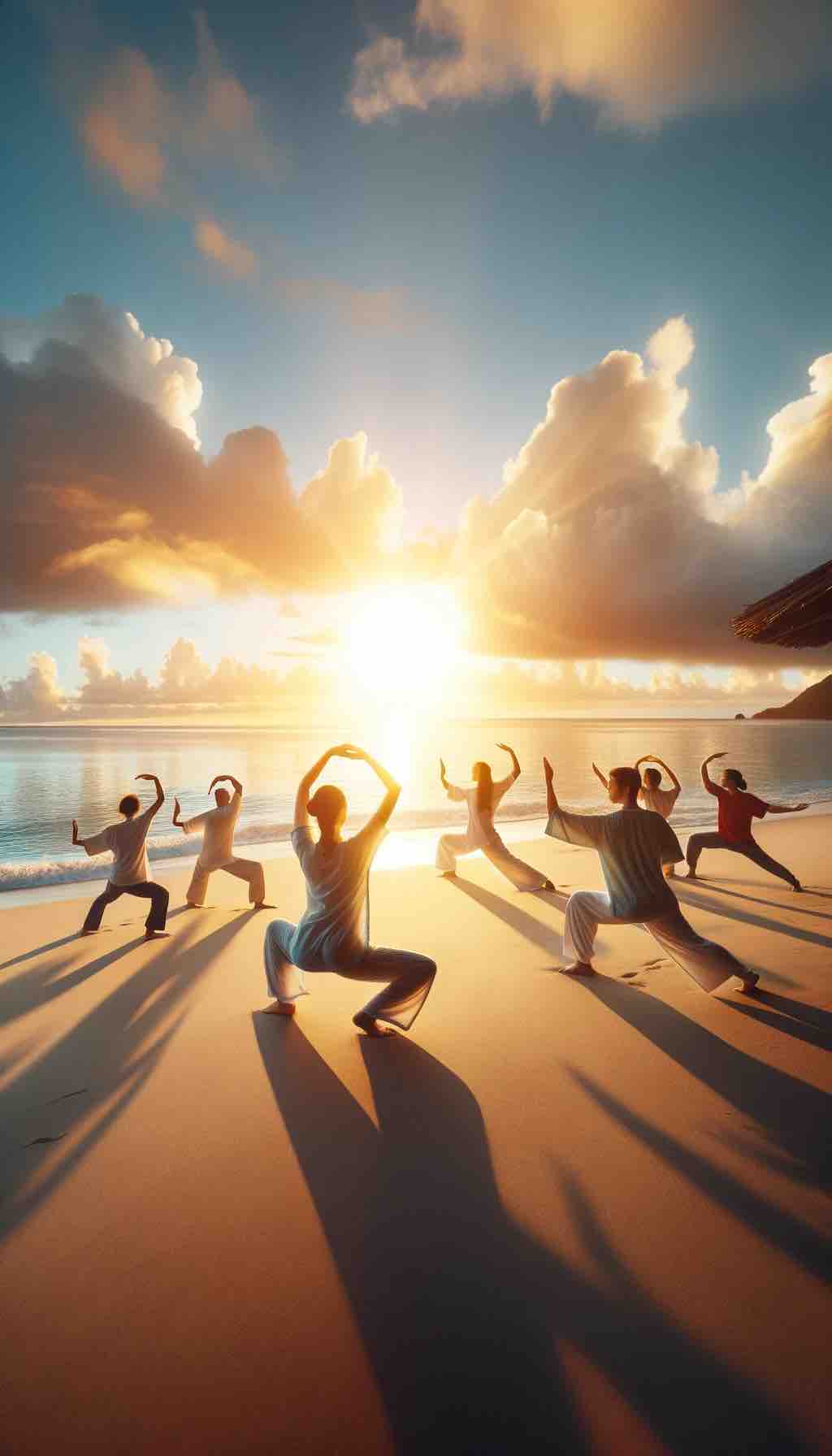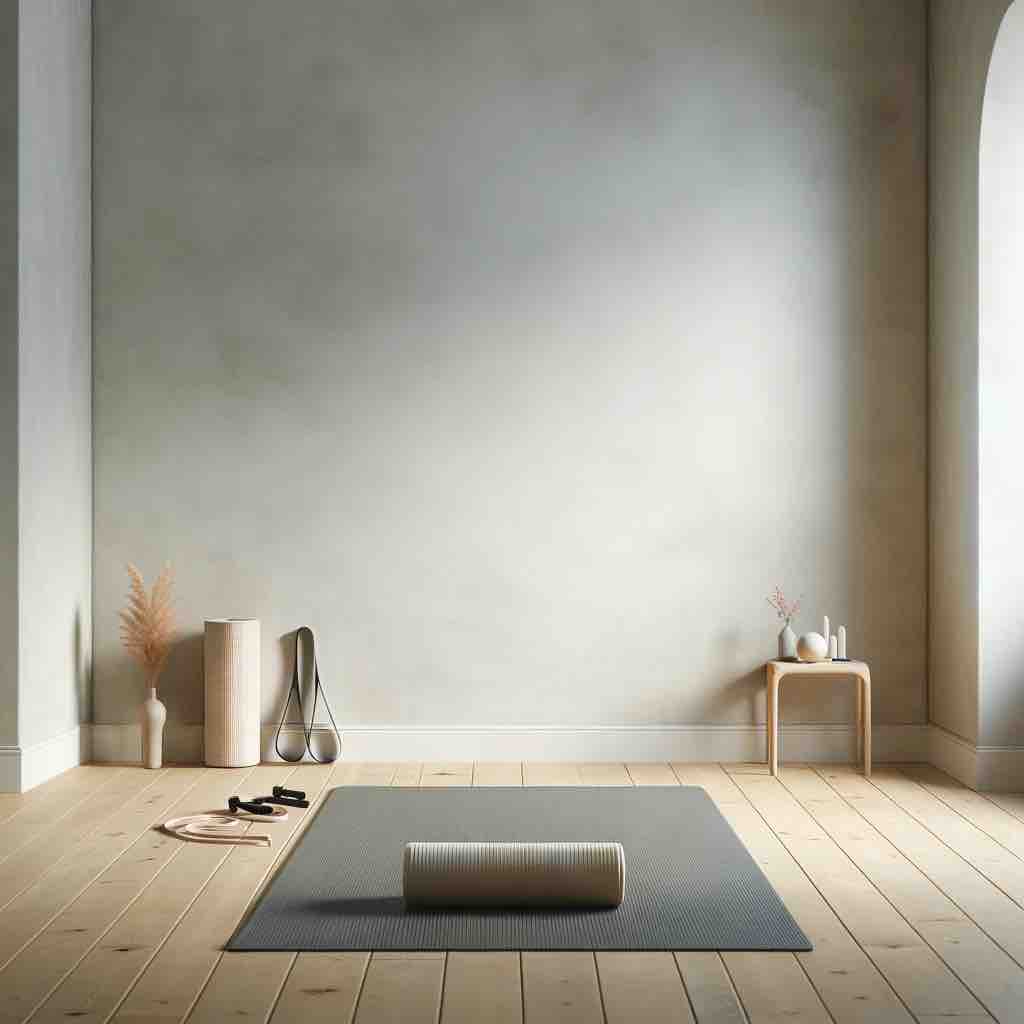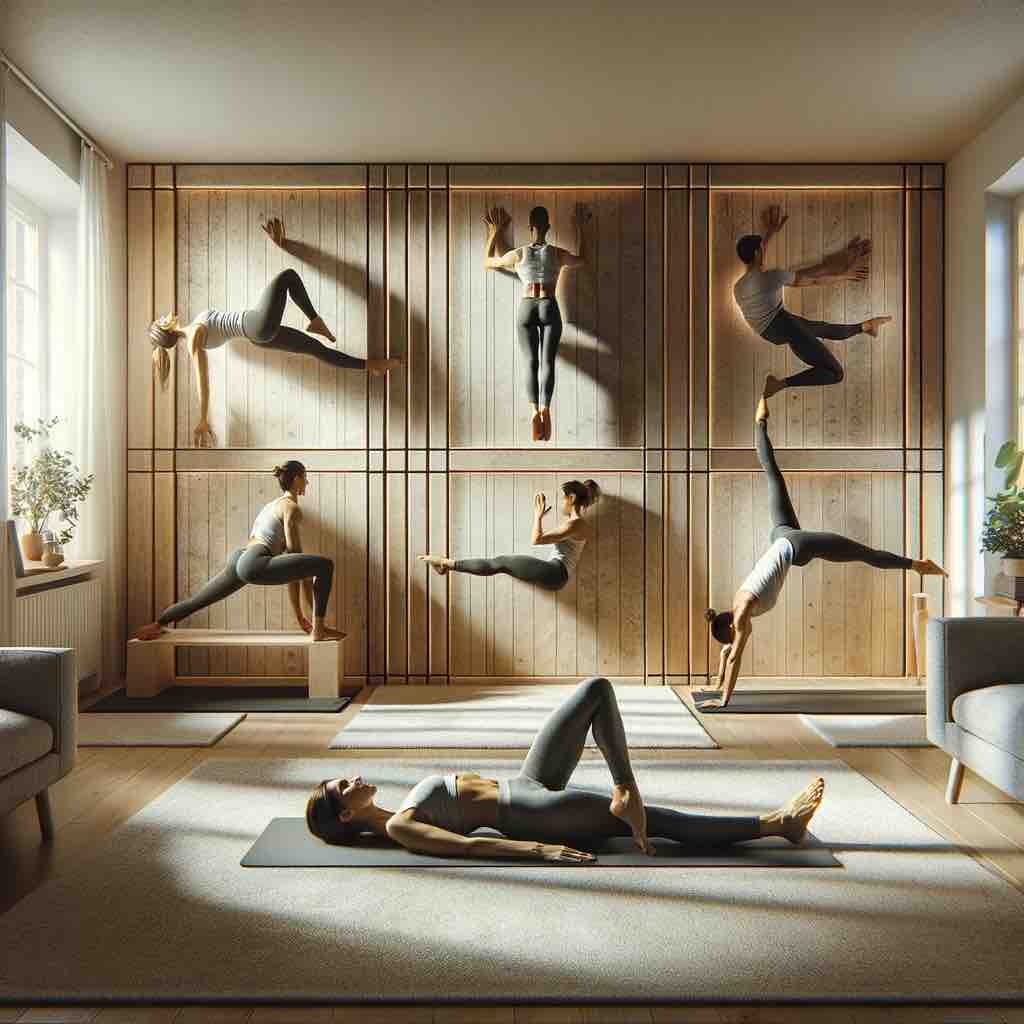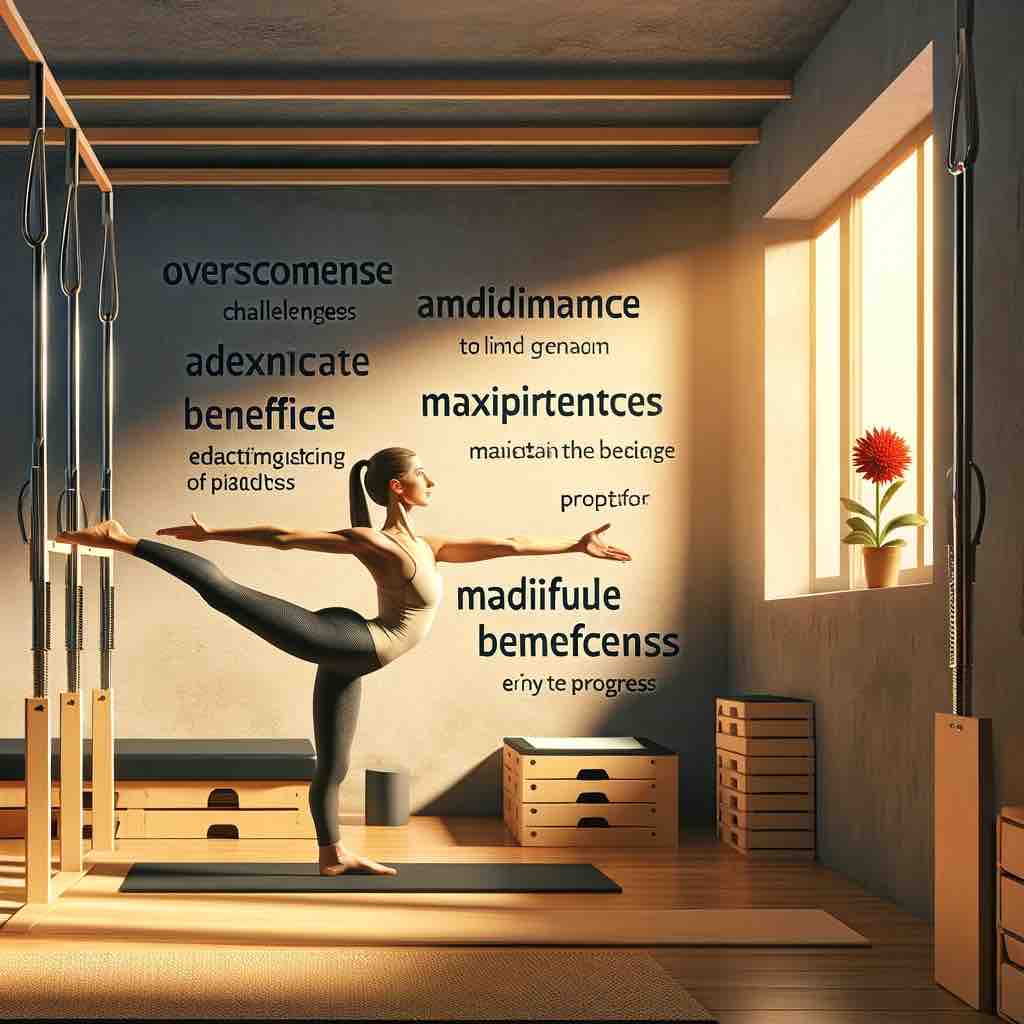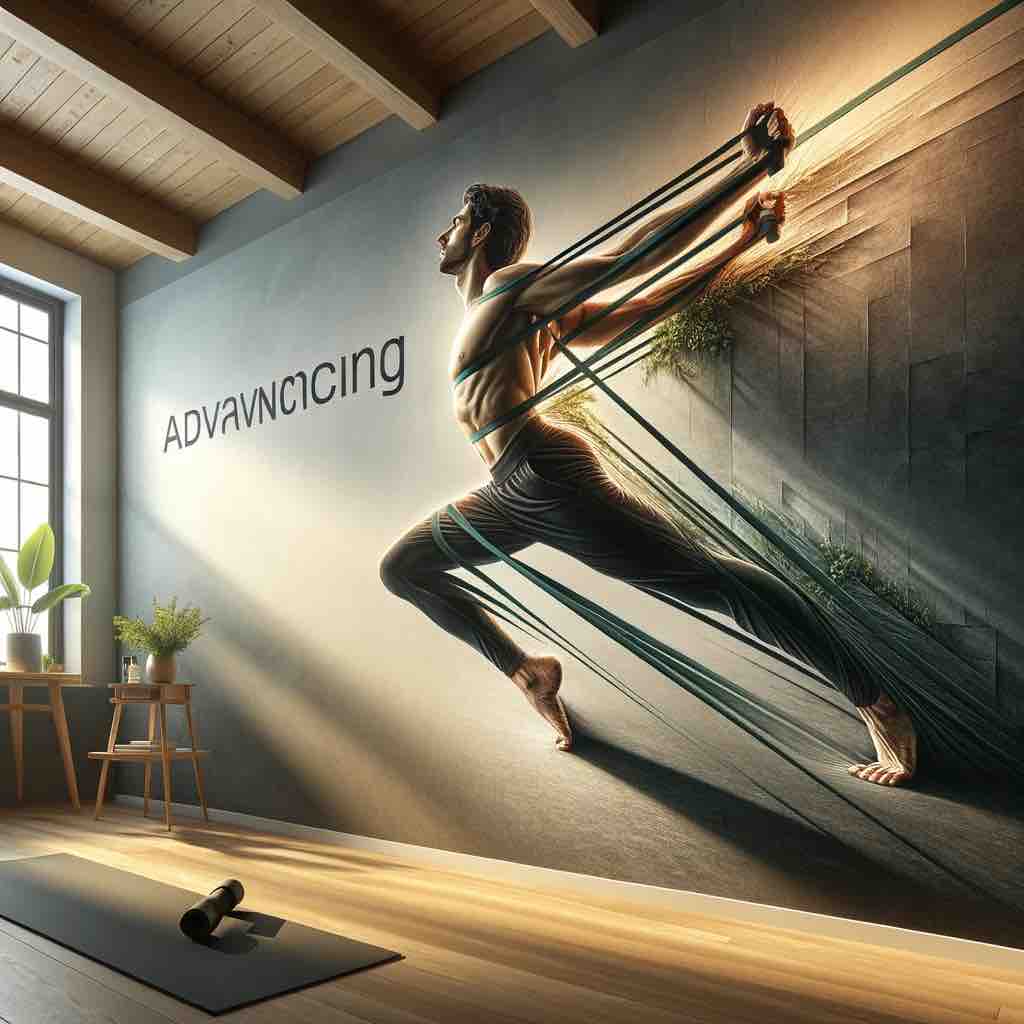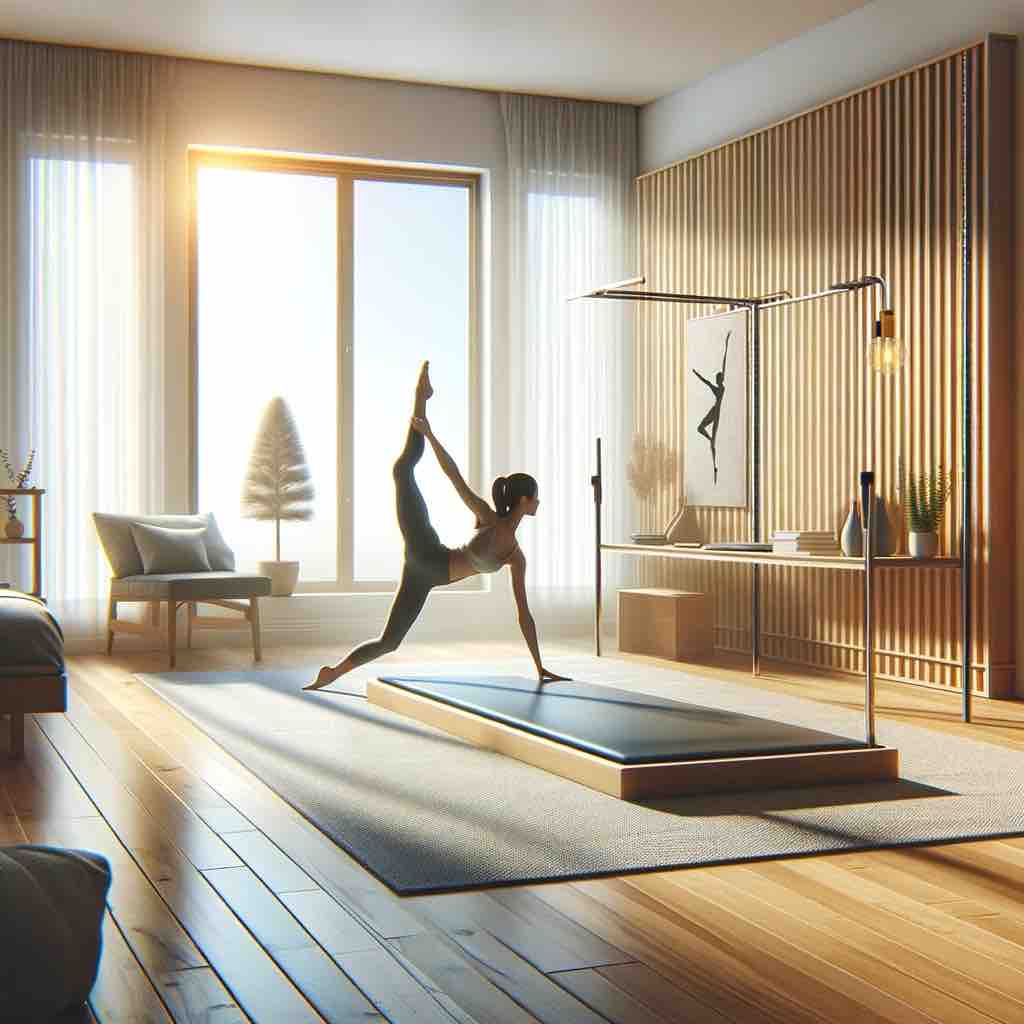
🌿 Introduction: Embrace the Wall Pilates Revolution
🌟 Redefining Home Workouts:
Welcome to the transformative world of Wall Pilates, a fitness phenomenon that’s reshaping home workouts into highly effective sessions of core strengthening, flexibility, and balance. If you’ve been browsing fitness trends online, you’ve likely come across this burgeoning sensation. It’s not just a workout; it’s a movement towards smarter, more efficient exercise.
🔍 What’s Wall Pilates?
Imagine merging the timeless elegance of Pilates with the practicality and support of a simple wall. That’s Wall Pilates for you – a novel approach to fitness that elevates traditional Pilates routines by incorporating the wall as a tool for resistance and support. It’s a full-body workout system that’s as effective as it is innovative.
🧘 Accessible, Effective, Transformative:
Whether you’re a dedicated fitness enthusiast or just starting your journey, Wall Pilates is remarkably inclusive. Requiring minimal equipment and space, it brings the studio experience into your home. It’s about making fitness accessible, enjoyable, and most importantly, effective.
🌈 Start Your Journey to Wellness:
Your journey to a stronger, more flexible, and balanced self begins right in the comfort of your home. With Wall Pilates, every session is an opportunity to explore new depths of strength and flexibility. So, roll out your mat, clear a spot near the wall, and step into a world where fitness meets simplicity and elegance.
🌟 Ready, Set, Transform:
In this guide, we’ll walk you through the incredible benefits of Wall Pilates, provide detailed instructions for core exercises, and share tips on integrating this practice into your daily routine. Get ready to reshape your approach to fitness, one wall-assisted movement at a time.
Section 1: Unraveling the Mystique of Wall Pilates
🔎 A Closer Look at Wall Pilates
Understanding the Concept:
Wall Pilates, at its core, is an innovative adaptation of traditional Pilates. It ingeniously uses a wall as a tool for support and resistance. This method not only brings a refreshing twist to familiar Pilates exercises but also opens up a myriad of new possibilities for enhancing your workout regimen.
The Evolution:
While traditional Pilates focuses on core strength, alignment, and mind-body connection, Wall Pilates takes these principles and amplifies them. The wall acts as a versatile prop, enabling a range of exercises that challenge your body in new and exciting ways.
🌟 Benefits of Integrating the Wall
Enhanced Muscle Activation:
With the wall providing resistance, exercises become more challenging, leading to increased muscle engagement and strength development, particularly in the core, glutes, and legs.
Improved Balance and Coordination:
The stability offered by the wall aids in developing better balance and coordination, an essential aspect of overall fitness and injury prevention.
Accessible and Adaptable:
Whether you’re a beginner or an experienced practitioner, Wall Pilates is highly adaptable. It offers support for newcomers while presenting opportunities for challenges as your skills progress.
🌈 The Wall Pilates Advantage
Innovative and Fun:
Wall Pilates brings an element of innovation and fun to your routine. It encourages creativity in workouts, making them more engaging and enjoyable.
Whole-Body Wellness:
It’s not just about physical strength; Wall Pilates enhances overall well-being. It aids in stress reduction, improves posture, and increases body awareness, contributing to a holistic approach to health.
Section 2: Mastering the Essentials of Wall Pilates
🌟 The Essence of Wall Pilates: A Deeper Dive
Understanding the Foundation:
Wall Pilates isn’t just a set of exercises; it’s a philosophy of movement that combines the core principles of traditional Pilates with the added dimension of a wall. It focuses on control, precision, breath, and fluidity, each enhanced by the stabilizing and resisting presence of the wall.
The Wall as Your Partner:
The wall in Wall Pilates isn’t merely a backdrop; it’s an active participant in your workout. As a multifaceted tool, the wall offers support, challenges your balance, and adds resistance, enabling a broader spectrum of movement and intensity in your exercises.
🔍 Delving into Core Wall Pilates Exercises
1. Wall Bridges for Lower Body Strength:
This exercise is a dynamic way to engage your glutes and lower back. With feet pressed against the wall, you elevate the traditional bridge, enhancing control and engagement.
2. Dynamic Wall Planks for Core Engagement:
Wall Planks are a comprehensive exercise targeting core strength and stability. The wall provides a stability challenge, allowing for numerous variations to target different core muscles.
3. Wall Squats for Leg and Glute Power:
These squats are ideal for building strength in your legs and glutes. The wall helps maintain proper alignment, allowing you to focus on form and depth, making the exercise effective for all fitness levels.
4. Graceful Leg Circles for Flexibility:
Leg circles are a testament to the control and precision that Wall Pilates promotes. Supported by the wall, you can concentrate on the fluidity and range of motion, enhancing leg flexibility and control.
5. Wall Push-Ups for Upper Body Conditioning:
Integrating push-ups with wall support can significantly improve upper body strength. The wall offers a unique resistance angle, engaging your arms, shoulders, and chest more effectively.
6. The Wall Roll-Down for Spinal Flexibility:
This exercise is fantastic for spinal health and flexibility. It involves a slow, controlled roll down against the wall, which helps in lengthening the spine and releasing tension.
🌈 Exploring the Benefits of Wall Pilates Exercises
Holistic Strength and Flexibility:
Each exercise in Wall Pilates is crafted to enhance both strength and flexibility. From core stability in planks to the spinal alignment in roll-downs, these exercises contribute to a holistic fitness experience.
Adaptability for Every Fitness Level:
One of the most appealing aspects of Wall Pilates is its adaptability. Exercises can be adjusted to cater to different strengths, making the practice inclusive for beginners, intermediate practitioners, and advanced enthusiasts.
Mind-Body Connection:
Wall Pilates emphasizes the Pilates principle of mind-body connection. It encourages mindfulness and concentration, making each session not just a physical workout but also a mental rejuvenation.
Section 3: Integrating Wall Pilates into Your Lifestyle
🌿 Embracing Wall Pilates as a Daily Practice
Seamless Integration into Daily Life:
Incorporating Wall Pilates into your daily routine is simpler than you might think. Its versatility allows for short sessions that can be easily fitted into busy schedules — whether it’s a morning routine to kickstart your day, a midday break for mental clarity, or an evening session to unwind.
Creating a Habit:
Consistency is key in reaping the full benefits of Wall Pilates. Establishing a regular practice, even if it’s just 10-15 minutes a day, can lead to significant improvements in strength, flexibility, and overall well-being.
🔍 Customizing Your Wall Pilates Routine
Tailoring to Your Needs:
Wall Pilates is highly customizable. Whether your focus is on strengthening, flexibility, or stress relief, you can tailor your routine to meet your specific goals and preferences.
Progressive Challenges:
As you grow more comfortable with the basics, gradually introduce new exercises or increase the duration and intensity of your sessions. This progression will help you continuously challenge and develop your body and mind.
🌟 Integrating Mindfulness and Relaxation
Beyond Physical Fitness:
Wall Pilates isn’t just a physical exercise; it’s a practice that fosters mindfulness and relaxation. Incorporating breathing techniques and mindfulness into your sessions can enhance mental clarity and reduce stress.
Creating a Mind-Body Connection:
Each session is an opportunity to deepen your connection with your body, listen to its cues, and move with intention. This mindful approach can lead to a more harmonious balance between physical fitness and mental well-being.
🌈 Making Wall Pilates a Part of Your Wellness Journey
Adaptable for All Ages and Fitness Levels:
Regardless of age or fitness level, Wall Pilates is an inclusive practice. It offers a safe and effective way for everyone to improve their health and fitness.
A Lifelong Companion:
Wall Pilates can be a lifelong companion in your wellness journey. Its adaptability and gentle nature make it a sustainable practice that can evolve with you over time.
Section 4: Overcoming Challenges and Maximizing Benefits
🌟 Identifying and Overcoming Common Challenges
1. Space Constraints:
Many assume that a large space is required for Wall Pilates. However, you only need enough room to extend your arms and legs. Creative use of space, like moving furniture temporarily, can make even small areas suitable for practice.
2. Maintaining Consistency:
Consistency can be challenging, especially for beginners. Setting a specific time for your practice or integrating it into existing routines, like after morning meditation or before evening relaxation, can help establish a regular habit.
3. Progress Plateaus:
If you feel your progress stalling, it might be time to vary your routine. Incorporating new exercises, adjusting the intensity, or even changing the time of day you practice can reinvigorate your Pilates journey.
🔍 Maximizing the Benefits of Wall Pilates
Enhanced Mind-Body Connection:
Focus on the mind-body connection in each session. Being mindful of your movements and breath can enhance the effectiveness of the exercises and provide a more holistic experience.
Integrating Complementary Practices:
Combine Wall Pilates with other fitness practices like yoga or light cardio. This not only keeps your routine fresh but also ensures a well-rounded approach to your overall health and fitness.
Listening to Your Body:
Pay attention to what your body tells you during your exercises. Adjusting movements to avoid discomfort and acknowledging when to push a bit further are key to a safe and beneficial Wall Pilates practice.
🌈 Sustaining Your Wall Pilates Journey
Building a Supportive Community:
Engage with online communities or local groups practicing Pilates. Sharing experiences, challenges, and successes can be motivating and enriching.
Tracking Your Progress:
Keep a journal or log of your Wall Pilates journey. Noticing improvements in strength, flexibility, or even mood can be incredibly rewarding and motivating.
Enjoying the Process:
Remember, the journey is as important as the destination. Enjoy each session, celebrate small victories, and embrace the ongoing process of learning and growing through Wall Pilates.
Section 5: Advancing Your Wall Pilates Practice
🌟 Evolving Beyond the Basics
Exploring Advanced Techniques:
As you grow more comfortable with basic Wall Pilates exercises, it’s time to explore advanced techniques. Incorporate challenging variations and new exercises that require more strength, balance, and flexibility.
Combining with Other Pilates Forms:
Expand your practice by integrating elements from mat or equipment-based Pilates. This fusion can provide a comprehensive Pilates experience, enhancing both your skills and enjoyment.
🔍 Developing a Personalized Pilates Routine
Customizing Your Sessions:
Tailor your Wall Pilates sessions to focus on areas you want to develop, whether it’s core strength, upper body toning, or flexibility. Design routines that align with your personal fitness goals.
Setting and Achieving Goals:
Set specific, achievable goals for your Wall Pilates practice. Whether it’s mastering a new pose, improving flexibility, or building core strength, having clear objectives can guide your progress.
🌈 Incorporating Props for Added Intensity
Using Pilates Accessories:
Introduce Pilates accessories like resistance bands, balls, or rings to add intensity and variety to your exercises. These props can help deepen stretches, add resistance, and challenge your stability.
Creative Use of Household Items:
Don’t have specialized equipment? No problem. Use common household items like towels or books to add a creative twist to your workouts. This approach keeps your practice both fun and cost-effective.
🌟 Exploring Group Classes and Online Resources
Joining a Community:
Participate in online classes or local Wall Pilates groups. Learning with others can provide valuable insights, inspiration, and a sense of community.
Leveraging Digital Resources:
Make use of online tutorials, apps, and virtual classes to explore new exercises and techniques. These resources can be a treasure trove of information for advancing your practice.
Section 6: Embracing Wall Pilates as a Lifestyle
🌿 Wall Pilates: More Than Just Exercise
Integrating Into Daily Life:
Wall Pilates is not just a fitness routine; it’s a lifestyle. Embrace its principles of balance, control, and mindfulness in everyday activities. Let the poise and alignment you learn in Pilates influence how you move through your day.
A Holistic Approach to Well-being:
Consider Wall Pilates as part of a broader approach to health. Combine it with a balanced diet, adequate sleep, and stress management techniques to enhance overall well-being.
🌟 Creating a Personal Pilates Space
Designing Your Pilates Sanctuary:
Create a dedicated space for your Pilates practice at home. It doesn’t need to be large; a quiet corner with your mat, a few props, and soothing decor can become your sanctuary.
Inspirational Environment:
Decorate your Pilates space with elements that inspire and motivate you. Plants, motivational posters, or calming colors can make your Pilates practice more enjoyable and rewarding.
🔍 Sharing the Joy of Pilates
Engaging With Family and Friends:
Introduce Wall Pilates to family and friends. Sharing your practice can be a fun way to spend time together and encourage each other’s fitness journeys.
Community Involvement:
Participate in community events or Pilates workshops. Engaging with the larger Pilates community can be a rewarding experience that deepens your appreciation for the practice.
🌈 Lifelong Learning and Growth
Continued Education:
There’s always more to learn in Pilates. Attend workshops, read books, or follow Pilates experts to continually expand your knowledge and skills.
Reflecting and Evolving:
Regularly reflect on your Pilates journey. Celebrate your progress, learn from challenges, and set new goals to keep evolving both physically and mentally.
Section 7: Looking Ahead – The Future of Your Wall Pilates Journey
🌟 Embracing Continuous Growth
Evolving with Experience:
As you progress in your Wall Pilates journey, your relationship with the practice will naturally evolve. Embrace this evolution as an opportunity to delve deeper into more advanced techniques and refine your understanding of Pilates principles.
Setting New Horizons:
Continually set new goals and challenges for yourself. Whether it’s perfecting a complex pose, increasing the duration of your practice, or exploring new variations of exercises, there’s always room for growth and improvement.
🔍 Staying Inspired and Motivated
Seeking New Inspirations:
Stay open to new sources of inspiration, whether from the Pilates community, fitness blogs, or social media. Inspiration can come from unexpected places and can reinvigorate your practice.
Maintaining Motivation:
Keep your motivation alive by celebrating small victories and acknowledging your progress. Remember why you started Wall Pilates and the benefits it brings to your life.
🌈 Adapting to Life’s Changes
Flexibility in Practice:
Life can be unpredictable, and your ability to adapt your Pilates practice to fit changing circumstances is crucial. Be flexible in how and when you practice, ensuring that Pilates remains a consistent and beneficial part of your life.
Incorporating Pilates Principles in Life:
Take the lessons learned from Wall Pilates – like balance, focus, and resilience – and apply them to other aspects of your life. This holistic approach can lead to a more balanced and fulfilling life experience.
🌟 A Lifelong Companion in Wellness
A Journey, Not a Destination:
Remember, Wall Pilates is a journey, not a destination. It’s a practice that can accompany you throughout your life, adapting to your needs and circumstances at every stage.
The Future of Your Practice:
Look forward to the future of your Wall Pilates journey with excitement and curiosity. With each practice, you’re not just strengthening your body but also enriching your life with greater health, balance, and well-being.
FAQs for Wall Pilates
1. What makes Wall Pilates different from traditional Pilates?
Wall Pilates enhances traditional Pilates by using a wall as a tool for support and resistance. This addition allows for a wider variety of exercises, targeting different muscle groups and offering both support and added challenge.
2. Can Wall Pilates help with weight loss?
While primarily focused on improving strength, flexibility, and posture, Wall Pilates can contribute to weight loss as part of an overall healthy lifestyle that includes a balanced diet and regular exercise.
3. Is Wall Pilates suitable for beginners?
Absolutely! Wall Pilates is adaptable to all fitness levels. Beginners can benefit from the wall’s support, making exercises more accessible and easier to learn.
4. How often should I practice Wall Pilates for the best results?
For noticeable results, aim for 2-3 sessions per week. Consistency is key, and even short, regular sessions can lead to significant improvements over time.
5. Do I need special equipment for Wall Pilates?
No special equipment is required. A yoga mat and a clear wall space are sufficient to start. As you progress, you might consider adding Pilates accessories like resistance bands or balls for variety.
6. How can Wall Pilates improve my overall fitness?
Wall Pilates offers a full-body workout that enhances core strength, flexibility, and posture. It also contributes to better balance and coordination, benefiting your overall fitness.
7. Can Wall Pilates be practiced during pregnancy?
While many find Wall Pilates beneficial during pregnancy, it’s crucial to consult with a healthcare provider and modify exercises as needed to ensure safety and comfort.
8. Are there any age restrictions for practicing Wall Pilates?
Wall Pilates is suitable for all ages. Its low-impact nature makes it particularly appealing to older adults seeking a safe form of exercise to maintain strength and flexibility.
9. How long does a typical Wall Pilates session last?
A typical session can vary from 20 to 60 minutes, depending on your schedule and fitness level. Even short sessions can be effective.
10. Can Wall Pilates help in rehabilitating injuries?
Wall Pilates can be an effective part of rehabilitation programs, especially for injuries related to muscle imbalances or poor posture. However, it’s important to seek advice from a medical professional and work with a qualified instructor.
Blog Tags for the Post
wall pilates, pilates exercises, home workout, fitness journey, core strength, flexibility training, mindful exercise, beginner pilates, advanced pilates, pilates lifestyle, health and wellness, body balance, pilates for all ages, injury rehabilitation, pilates tips, holistic health, pilates guide, fitness motivation, improving posture, low-impact workout
